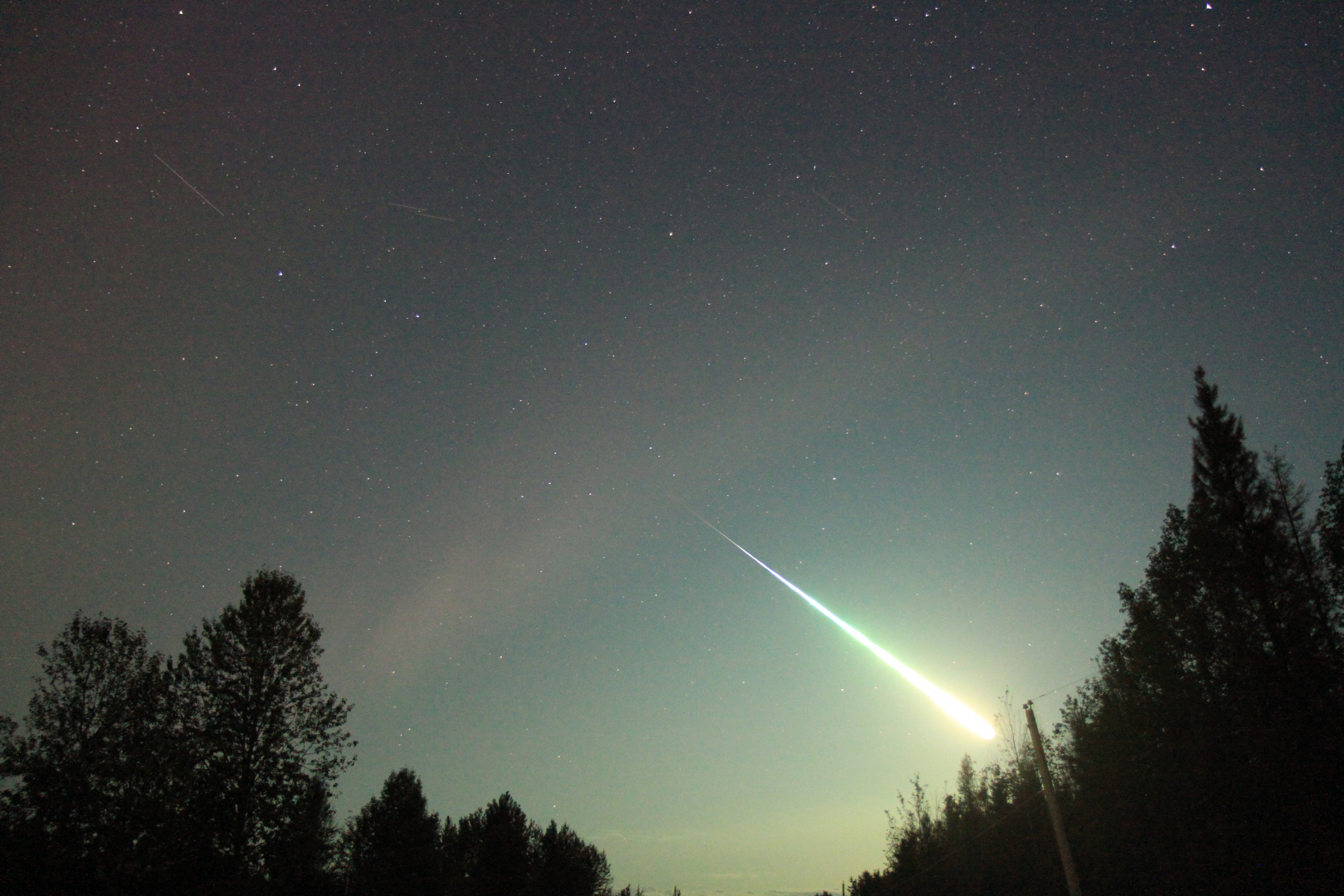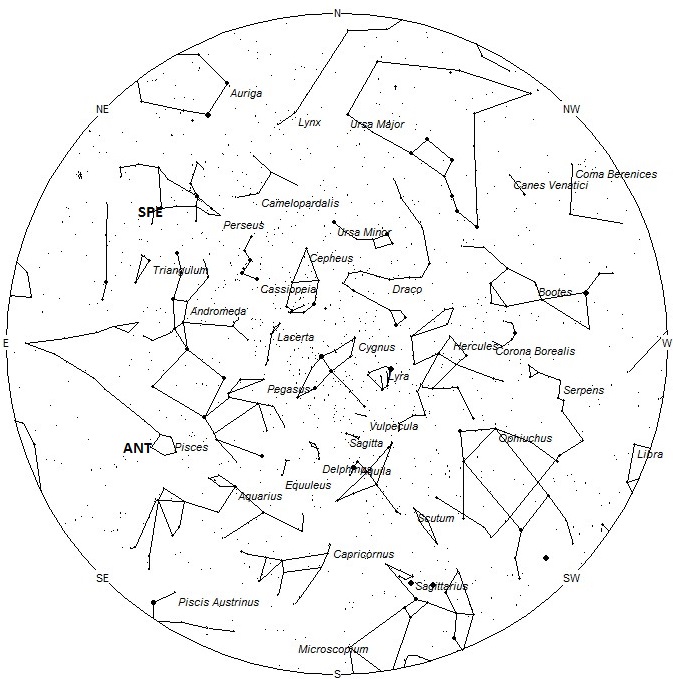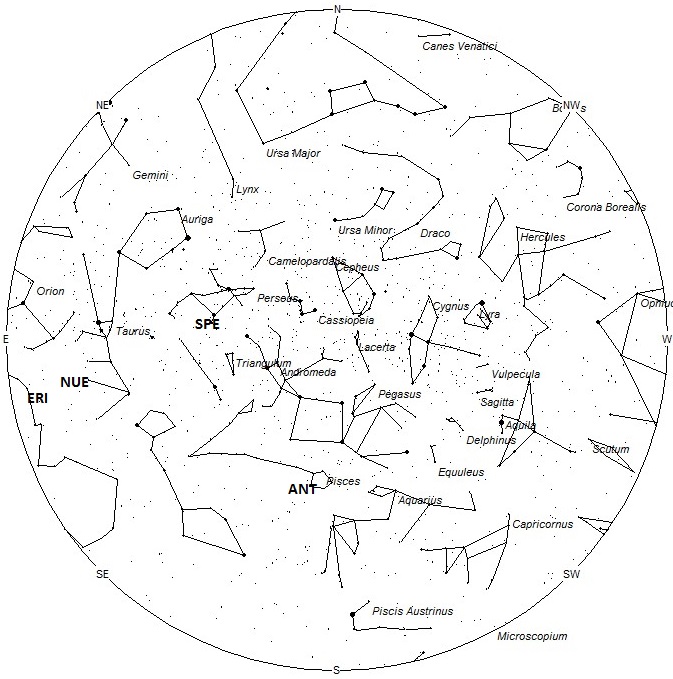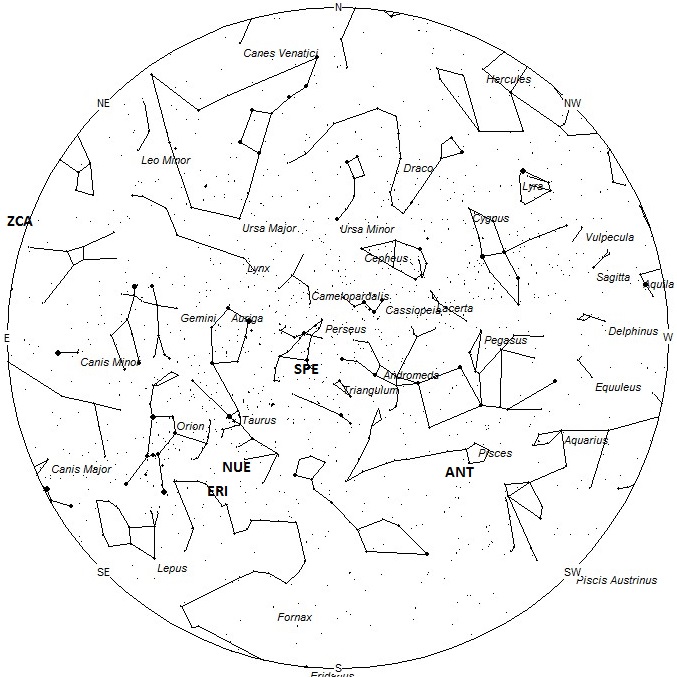
During this period the moon’s phase waxes from just past its first quarter phase to nearly full. This weekend the moon’s phase will be a waxing gibbous that will set soon after midnight local summer time (LST). This is good timing as the more active morning hours will be free of moonlight. With each passing night this window of dark sky shrinks until the moon sets near the start of dawn late in the week. The estimated total hourly meteor rates for evening observers this week is near 4 for those viewing from the northern hemisphere and 3 for those located south of the equator. For morning observers the estimated total hourly rates should be near 15 as seen from mid-northern latitudes (45N) and 9 as seen from tropical southern locations (25S). The actual rates will also depend on factors such as personal light and motion perception, local weather conditions, alertness and experience in watching meteor activity. Evening rates are reduced during this period due to moonlight. Note that the hourly rates listed below are estimates as viewed from dark sky sites away from urban light sources. Observers viewing from urban areas will see less activity as only the brightest meteors will be visible from such locations.
The radiant (the area of the sky where meteors appear to shoot from) positions and rates listed below are exact for Saturday night/Sunday morning September 7/8. These positions do not change greatly day to day so the listed coordinates may be used during this entire period. Most star atlases (available at science stores and planetariums) will provide maps with grid lines of the celestial coordinates so that you may find out exactly where these positions are located in the sky. A planisphere or computer planetarium program is also useful in showing the sky at any time of night on any date of the year. Activity from each radiant is best seen when it is positioned highest in the sky, either due north or south along the meridian, depending on your latitude. It must be remembered that meteor activity is rarely seen at the radiant position. Rather they shoot outwards from the radiant so it is best to center your field of view so that the radiant lies at the edge and not the center. Viewing there will allow you to easily trace the path of each meteor back to the radiant (if it is a shower member) or in another direction if it is a sporadic. Meteor activity is not seen from radiants that are located below the horizon. The positions below are listed in a west to east manner in order of right ascension (celestial longitude). The positions listed first are located further west therefore are accessible earlier in the night while those listed further down the list rise later in the night.
These sources of meteoric activity are expected to be active this week.
.
The center of the large Anthelion (ANT) radiant is currently located at 23:52 (358) -01. This position lies in western Pisces, 3 degrees southeast of the 4th magnitude star known as lambda Piscium. Due to the large size of this radiant, anthelion activity may also appear from eastern Aquarius as well as western Pisces. This radiant is best placed near 01:00 (LST), when it lies on the meridian and is located highest in the sky. Rates at this time should be near 2 per hour no matter your location. With an entry velocity of 30 km/sec., the average anthelion meteor would be of slow velocity.
The September Epsilon Perseids (SPE) are active from September 3 through October 3 with the peak occurring on September 11th. The radiant is currently located at 03:01 (045) +39. This position lies in southwestern Perseus, only 1 degree northwest of the 3rd magnitude star known as Gorgonea Tertia (rho Persei). The radiant is best placed near 0500 LDT, when it lies highest above the horizon. Rates are expected to be near 1 as seen from the northern hemisphere and less than 1 as seen from south of the equator. With an entry velocity of 65 km/sec., most activity from this radiant would be swift.
The nu Eridanids (NUE) were co-discovered by Japanese observers using SonotoCo and Juergen Rendtel and Sirko Molau of the IMO. Activity from this long-period stream stretches from August 24 all the way to November 16. Maximum activity occurs on September 24th. The radiant currently lies at 04:08 (062) +03, which places it in southwestern Taurus, 3 degrees southeast of the 4th magnitude star known as nu Tauri. This area of the sky is best seen during the last dark hour before dawn when the radiant lies highest in a dark sky. Current rates are expected to be less than 1 per hour during this period no matter your location. With an entry velocity of 67 km/sec., the average meteor from this source would be of swift velocity.
The eta Eridanids (ERI) were discovered by Japanese observers back in 2001. Activity from this stream is seen from July 23 through September 17 with maximum activity occurring on August 11. The radiant currently lies at 04:33 (068) -04 which places it in western Eridanus, 2 degrees west of the 4th magnitude star known as mu Eridani). This area of the sky is best seen during the last dark hour before dawn when the radiant lies highest in a dark sky. Current rates are expected to be less than 1 per hour during this period no matter your location. With an entry velocity of 65 km/sec., the average meteor from this source would be of swift velocity. Note that this position is close to that of the nu Eridanids. Care must be taken to separate these two sources.
The last of the Daytime zeta Cancrids (ZCA) are expected this week. This stream is active from August 13 through September 10 with maximum activity occurring on September 3rd. The radiant is currently located at 09:22 (141) +11, which places it on the Cancer/Leo border, 4 degrees east of the 4th magnitude star known as Acubens (alpha Cancri). This area of the sky is located only 30 degrees west of the sun so any possibility of seeing these meteors would be limited to the time just before the start of morning twilight. Current rates are expected to be less 1 per hour no matter your location. With an entry velocity of 42 km/sec., the average meteor from this source would be of medium velocity.
As seen from the tropical southern latitudes (25S), one would expect to see approximately 7 sporadic meteors per hour during the last hour before dawn as seen from rural observing sites. Evening rates would be near 2 per hour. As seen from mid-northern hemisphere (45N), morning rates would be near 11 per hour as seen from rural observing sites and 3 per hour during the evening hours. Locations between these two extremes would see activity between the listed figures. Evening rates are reduced during this period due to moonlight.
The list below offers the information from above in tabular form. Rates and positions are exact for Saturday night/Sunday morning except where noted in the shower descriptions.
| SHOWER | DATE OF MAXIMUM ACTIVITY | CELESTIAL POSITION | ENTRY VELOCITY | CULMINATION | HOURLY RATE | CLASS |
| RA (RA in Deg.) DEC | Km/Sec | Local Summer Time | North-South | |||
| Anthelion (ANT) | – | 23:52 (358) -01 | 30 | 02:00 | 2 – 2 | II |
| September Epsilon Perseids (SPE) | Sep 11 | 03:01 (045) +39 | 65 | 05:00 | 1 – <1 | II |
| nu Eridanids (NUE) | Sep 24 | 04:08 (062) +03 | 67 | 06:00 | <1 – <1 | IV |
| eta Eridanids (ERI) | Aug 11 | 04:33 (068) -04 | 65 | 06:00 | <1 – <1 | IV |
| Daytime zeta Cancrids (ZCA) | Sep 03 | 09:22 (141) +11 | 42 | 11:00 | <1 – <1 | IV |







 You saw something bright and fast? Like a huge shooting star? Report it: it may be a fireball.
You saw something bright and fast? Like a huge shooting star? Report it: it may be a fireball.  You counted meteors last night? Share your results with us!
You counted meteors last night? Share your results with us!  You took a photo of a meteor or fireball? You have a screenshot of your cam? Share it with us!
You took a photo of a meteor or fireball? You have a screenshot of your cam? Share it with us!  You caught a meteor or fireball on video? Share your video with us!
You caught a meteor or fireball on video? Share your video with us!